DAY 31 - A VISIT TO FREDERIKSBORG CASTLE - Tuesday 24th May, 2022.
he weather forecast was for rain today so we
decided to tackle Frederiksborg Castle today.
We had previously been here 6 years ago but only had a couple of hours
in the castle itself before closing time and had no where near enough time to
explore it properly. We had spent a good
deal of time in the gardens last visit, so decided with the wet weather it was
a great opportunity for us to spend more time exploring the interior of the
castle. Nothing prepares you for the visual indulgence
that greets you as you enter the castle. Situated on a lake, is a stunning fairy tale red
bricked castle with verdigris roofs, impressive turrets and gold domes. We were there for almost six
hours and still felt like we were rushing through.
 |
| Arriving at the Castle in the town of Hillerød |
 |
| Frederiksborg Castle looms in the background |
The history of the castle is very interesting. It still amazes us that the length of the time it took to build the castle means that those who started the build were not around to see it completed. In 1560 King Frederik II acquired Hillerødsholm Manor and constructed the first part of Frederiksborg Castle. But between 1600 and 1620, his son, Christian IV demolished the castle, before building the Dutch Renaissance style castle we know today. Frederiksborg Castle is the largest Renaissance Castle in Scandinavia today and was built as a residence for King Christian IV himself.
While the Castle was being built, Christian IV resided in a large, Italian-style pleasure palace by the name of Sparepenge, which he had built on the other side of the lake. Frederiksborg Castle was then used as a royal residence for the following one hundred years.
In
1720 Christian IV’s pleasure palace was demolished and then replaced by the
stunning Baroque garden we see today. The actual Castle was also renovated in the 1730s, but
ceased to be used as a royal residence after Christian's death. It was then used to house the royal collection of portraits and also for ceremonies. From 1671 to 1840 all Danish Absolute Monarchs were crowned and anointed in the Chapel at Frederiksborg Castle except for King Christian VII. The Treaty of Frederiksborg which ended the Great Northern War between Sweden and Denmark-Norway from 1700-1721 was also signed here in 1720.

After 1850 Frederiksborg Castle gained a new lease of life when King Frederik VII moved in. He married Louise Ramussen, who later become known as Countess Danner.
The royal couple renovated the Castle to make their home more contemporary. This included the installation of several fireplaces and stoves to heat the large rooms.
While he was staying there on the night of 16 December 1859, he retired to a room on the third floor to examine his historic artefacts. But as it was a cold night, he asked for a fire to be lit in the room. Unfortunately, the chimney was under repair, causing a fire to break out. As the lake was frozen, the only water available came from the pantry and the kitchen. The fire spread rapidly throughout the castle and by morning almost the entire palace had been severely damaged or destroyed and some parts burnt down to the ground. With the help of local firemen and helpful citizens they were able to save the Audience building with the passage and the hall together with the entire Chapel from the heavy flames. After the destroying fires swept through the rest of the castle - it was left as a huge ruin with only the bare wall left to support the original building structure - and most of the precious intricate interior decorations and artwork was lost for ever. Staff had worked throughout the night to save over 300 priceless paintings and smaller historical items from the 15th and 16th century. These pieces are now on display at the museum today.
I really am not sure how they managed this as some of these paintings are huge and would have taken several people to move them. Having seen now a lot of these priceless pieces, one can only imagine the amount of other priceless pieces that were also lost.
Apparently after the fire, the royals stayed in another one of their residences whilst Frederiksborg Castle was being rebuilt. The restoration and reconstruction work began in 1860 on the basis of old plans
from the archives as well as detailed paintings and drawings by Heinrich Hansen. But, after a short period of time, the royals decided to abandon the reconstruction of the castle as it was too much of a financial drain on their coffers and since they had other large manor houses they felt like it wa an unnecessary expense to finish rebuilding.
In 1878, the philanthropist and brewer, J. C. Jacobsen, the founder of Carlsberg Brewery, had the grand idea to turn the disused Palace into a museum. Jacobsen was a passionate collector and he loved his country and thought it was a travesty to see this beautiful piece of history deteriorating in the countryside. He offered to pay for all it's reconstruction and any further expenses. He also provided the funds for the establishment of a Museum of National History. The Palace is still run to this day by the Carlsberg Foundation.
At the end of 1878 the meticulously reconstruction work which was under the supervision and leadership of the historicist architect Ferdinand Meldahl was completed, the castle was once again restored and brought back to its original appearance from the time of King Christian IV. J. C. Jacobsen also donated a copy of the Neptune Fountain, (the original fountain by Adrian de Vries was taken to Sweden during one of the wars) which was placed in the outer courtyard in 1888.
The Museum of National
History was founded in 1878 and in 1882 the museum was inaugurated and opened its
doors to the public.
I would definitely recommend a visit to the Castle and I know that we will also visit again. The Castle museum features 500 years of Danish history which has been
woven throughout the walls of the palace. There are portraits, paintings
of historic events, antique furniture and decorative arts dotting the
entire palace, creating a timeline of Danish life. Seeing these pieces in-situ,
rather than just clumped together in a modern gallery, makes history
come alive! Many portraits along these walls are of some of the most
famous Danes and Royals who helped shape the face of their country and
even lived within the walls of the castle. Every time you visit, you see something different or take away more from your visit. I think the visit this time, involved a lot more of an understanding of the history a lot more. Our first visit, we were just in awe of the grandeur and it was almost like a sensory overload.
There is always some sort of restoration work being carried out at the castle thanks to the funding set up through the Museum of National History. This visit there was scaffolding up and work was being done on the towers. I can imagine that it would be an on going project.
There is just so much to see even before you get into the castle and you could spent an hour or two just in the courtyards of the castle..
As you pass through the gatehouse to the Castle you emerge into the first courtyard. In the centre of this courtyard the rather impressive and commanding Neptune Fountain is housed. The fountain was initially made in honour of the naval forces in Denmark which were the leading army on the Baltic seas.
 |
| Neptune's Fountain |
At the very top of the fountain is the great sea god Neptune. He stands with his hand outstretched reaching out towards us. In his other hand is the great Tritan, at the ready to defend Denmark.
Below him, on pedestals around the central column, are gorgeous rivers and spring deities. Surround the lowest level of the fountain are water nymphs. In their hands, they play seashell trumpets. Water spurts forth from these decorations to exalt their great leader Neptune.
The original fountain was designed by Dutchman Adrian de Vries in 1617. The one standing there today is an replica of the original and this is because the original fountain, in its entirety was stolen by the Swedes during the Swedish Wars. The original fountain is now at the Summer Palace in Drottningholm in Sweden.
On either side of the Neptune fountain are two thin buildings. On the left is the Castellan's lodge and on the right, the Chancery Building... A castellan is an appointed official, a governor of a castle and its surrounding territory. The chancery is the building that houses diplomatic missions, such as the Danish embassy. Both of these places were of great importance to the function of the royal family and the government..
As we turned to make our way from Neptune Fountain towards the castle we had a wonderfully unobstructed view of the grandeur that is Frederiksborg Castle. As I stated before the castle was designed in the classic Dutch Renaissance tradition and is very majestic. Frederiksborg is shaped in a quadrangular structure. Dutch Renaissance architecture used red bricks for the exterior and the buildings were topped with stepped gables and towering copper spires.
The narrow street you walk down after passing under the gate is known as Staldgaden which translate to housing street as this was where all the servants to the king's court lived. When we walked down this narrow cobblestone pathway there were two single storey buildings and these were the King's stables on the western side and then the Hussars' stables on the eastern side.
At the back of the stables are two matching towers dubbed the Frederik II's Round Towers. These towers were built in 1562 and bear the coat of arms of Frederick II. On the coat of arms is the motto "Mein Hoffnung zu Gott Allein"which means "My hope to God alone".
I remember on our first visit to Frederiksborg Castle back in 2016, we were hugely impressed with the size of this castle, the massive amounts of bricks used in the castle and walls, towers, stables etc. It is hard to even fathom the enormous amount of work that went into building this amazing structure. It is hard to even image something of this size and grandeur being built today. The building costs would be astronomical, never mind the craftsmanship needed to decorate the castle as it is today.
To get to the main entrance to the castle we had to walk through a large central and somewhat majestic doorway that leads to a secondary courtyard. On top of this doorway is a great sandstone work of art carved into the portal. This is the monogram of Christian IV. The large "C4"is chiselled into a circular coin shape and surrounded by rich foliage. On either side of the monogram are two small carvings in the shape of a man and woman. On the left is the image of King Christian and on the right it is the image of his wife, Anne Catherine of Brandenburg.
On either side of the bridge we walked across to enter the inner courtyard, we came across two large sandstone statues of great lions. The lions were reared up on their back legs, with their paws wrapped around a large orb. Orbs are seen frequently in royal symbolism and apparently represent the globe. The lions with their hands wrapped around it represents the Danish power wrapping around the world.
Along the outer wall of the inner courtyard on either side of the large doorway, we were impressed with a rather elaborate decorated set of sculptures under an ornamented balustrade. Inside each of these little niches were sculptures of characters from astrology and mythology. The Dutch Renaissance loved these themes and this all added to the fairytale nature of the castle. We found that included in these statues were images of Alexander the Great and Julius Caesar, two amazing historical leaders that the Danish Kings wanted to mirror in their own leadership...
 |
| Standing in the inner courtyard with the clock tower in the background. |
Once again when walking through the doorway into the inner courtyard your senses are hit with overload as you take in the Great Gallery from 1621. This gallery is made up of a series of sculptures across the front of the King's Wing. These statues are of various Gods and notable historical leaders. They were made by "Hans van Steenwinckel the Younger" in Amsterdam and brought to Denmark by ship. On the right, under a small copper dome, is the entrance to the castle well, which you can still see behind a wrought iron gate.
One of the things we did notice particularly in the courtyard here and throughout the castle was the use of columns. We were told that the Roman and Greek architecture had profoundly influenced the Dutch Renaissance and this could definitely be seen in the use of all the columns as adornment in the castle. Unlike the Greek architecture though, these columns here and their mouldings were richly decorated and bas reliefs were carved into any flat surface.
The huge clock tower is marked by golden clockfaces. The tower features a clock face on either side of the building, so that no matter where you are in the palace, you can look out and see the time. The dials on the clock end in the shape of a star burst and are set against a backdrop of a golden sun.
The church is located under the clock tower and it is probably the reason why this tower is so richly decorated. This one wing was the only one to survive the horrific fires and therefore much of the restoration work was done to mirror these original designs. At the top of the clock tower is a golden spire with a horse and crown atop it...
From this exterior courtyard, looking up at the windows and bay windows that protrude from the castle walls, we noticed the sumptuously decorated stained glass, which once again is another popular feature of Renaissance architecture. There was everything from family crests to royal symbology and historical portraits are all represented in this delicate glasswork.
 |
| The beautiful carved entrance doors to the Chapel. |
 |
| The Gargoyles along the inside courtyard walls. |
These gargoyles are carved or formed grotesque creatures with a spout designed to convey water from a roof and away from the side of a building, much like guttering does in our day. These are used to prevent water from running down masonry walls and eroding the mortar between. Architects often used multiple gargoyles on a building to divide the flow of rainwater off the roof to minimize potential damage from rainstorms. A trough is cut in the back of the gargoyle and rainwater typically exit through the open mouth. They are usually elongated fantastical animals because their length determines how far water is directed from the wall.
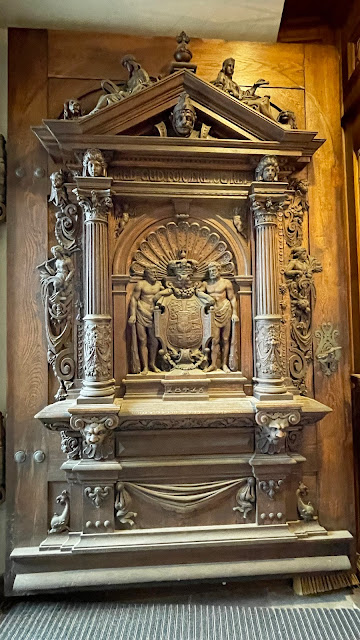 |
| Entrance to the Castle |
We finally got to the main door of the Castle, and again it was another intricately carved solid heavy timber door.
Admission to the castle is heavily subsided by the Danish Government as they really do like to make Museums and places of national history affordable to all their citizens. The Danes are very proud of their history and their country.. Entrance cost was around $25 Aus which is very reasonable. Wandering the gardens and grounds can be done for free...
The first room we entered after paying our admission gate was the great Rose Room. I will never forget the look on Steve's face the first time we visited this castle and he walked into this room. His jaw just dropped, he was gobsmacked at the detail in the ceilings. I will never forget that look. This time his jaw didn't drop the same, although I think this time, we took in a little more of the detail as we were not rushing to get through the palace.
This room is on the lower level of the castle and is a recreation of the Great Dining Room of King Christian IV. The naming of this room as the "Rose Room" is a hint at the true nature of the goings on at royal dinner parties. The Latin phrase "sub rosa" means "under the nose", and apparently is used in English to denote secrecy or confidentiality. This dining room was where the court could come and be themselves away from the eyes of the public...
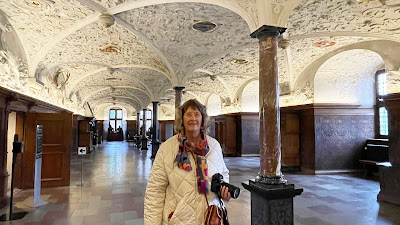 |
| The Rose Room |
This room was severely damaged during the fire, but luckily, dozens of paintings were made of the interiors of the castle, which were used to recreate these rooms authentically.
 |
| Beautiful marble columns throughout the Rose Room |
One of my favourite parts of this room is the white stucco ceilings supported by six vaults which rest on free-standing pillars. In the centre of the extremely detailed ceiling are various golden monograms set in a sea of white stucco flowers and vines. The juxtaposition of the white ceiling and dark wood floors is a beautiful piece of architectural contrast.The wallpaper in this room is also especially interesting. It was made of an imitation leather material and covered in gilt to make it look as rich as possible. It is like running your fingers along the spine of an ancient book and this wallpaper covers the entire room. Amazing...
 |
| A painting of the great fire that destroyed the castle. |
From here we checked out one of the hallways to one of the other wings of the castle. This hallway looked out over the amazing Baroque Gardens and the Lake.
 |
| Views from the windows in the hallway |
 |
| More views looking out over the stunning Baroque Gardens |
 |
| On this armour, your fingers are protected by leather strips... |
When we arrived at the castle, we noticed that they had portable stools that you could carry around with you so that if you needed to sit during your visit to the castle you had your own portable chair. With my back and knees the way they are we thought this was a great idea and we grabbed one to carry with us.. It came in very handy as we spent a good six hours in the castle and there was no way I would have lasted on my feet all day..
We also thought we had better make a pit stop to the toilet before going too far into exploring the castle as there are not many toilets in buildings such as these. We headed back to the tower room as this was were the access to the toilets were. The toilets were situated in the lower secret passageway below the castle. Whilst we were down there we also checked out the exhibition of sculptures and reliefs from the Castle's original decoration, along with some of the archaeological finds from excavations around the area near the castle.
From here we headed back upstairs and then took the amazing staircase up to the next level to view the breathtaking Chapel.
 |
| The walls of the staircase are lined with the shields of Danish royalty. |
To get to the Chapel we had to ascend up the winding staircase. This passageway leads you straight into the Chapel. On the way up the stairwell you pass hundreds and hundreds of shields, emblazoned with the coats of arms of the houses of Denmark's royal families. They are almost piled one upon the other, and they definitely make you aware of the legacy that Denmark's royal families have left on the country. There are over 3,500 of these shields in the castle, 400 of them belong to the "Order of the Elephant" and the remaining 3,100 belonging to the "Order of Dannebrog". Because the staircases were spared from the fire, all the shieldson display are actually the original ones...
Before walking into the chapel, we walked through a small room with had a chronological account of the past 500 year of Danish history. It was amazing, the history of Denmark is portrayed through portraits, history paintings, furniture and applied art. The detail was amazing and it really did allow you to see the people and events that helped shape the history of the country from the Late Middle Age to the 21st century.
Even though we had been and seen the Chapel before it still produced that jaw practically dropping to the floor feeling. The sparkle of the golden ceiling the bright glimmer of the stained glass windows and the brilliant red pews together combine to create such an awe-inspiring image.
The Chapel is one of the few original rooms in the palace, as it was also spared by the great fire that consumed the rest of the building. The chapel is so awe inspiring that this blog is getting photo bombed with photos of this majestic chapel.
 |
| Jaw dropping spectacular Chapel at Frederiksborg Castle. |
The Chapel was built in 1617, right in the middle of the great Dutch Renaissance. Since the Renaissance was all about reflecting the architectural styles of ancient Rome and Greece, there is a powerful use of columns, repeated to create a long nave and two-storey gallery. The arches which connect the pillars are richly decorated with grisaille frescos. Grisaille is a painting technique that uses only shades of grey to imitate the looks of sculptures. It was a method of achieving a more luxurious look at half the cost.
Paintings decorate the walls of the upper level. These paintings are from the Danish royal family’s art collection and each one depicting scenes from the bible, featuring virtues that would befitted feature kings and inspired their good nature.
The Chapel inside Frederiksborg Castle was for more than just the king’s private prayer room. After 1648, the chapel was the place where the future kings and queens of Denmark were crowned and anointed. It truly was an almost godly interior.The impressive gold, silver and ebony altarpiece was made by the Hamburg goldsmith, Jacob Mores in 1606.
Some of the truly beautiful dramatic stained glass windows and ornate columns within the chapel. I think it would be hard to really worship in this chapel, as you would be too busy eyeing off all the beauty within the chapel.
The chapel is still used as a place of worship today and many weddings are held here... I can understand why...
For me, the roof is the real show stopper here. The six-vaulted stucco ceiling is pouring with golden embellishments and rosettes along the vault ribs bloom like they are in the middle of summer sunlight. In between, there are delicately painted pink cherubs looking down on the faithful below.
The other gem within the Chapel is the beautiful Compenius organ. It was built in 1610 by Esajas Compenius and it's the oldest organ in Denmark. It was a gift to Christian IV in 1617 when the chapel was consecrated. Despite it's proximity to the great fire, the original wooden pipes were preserved. Wooden pipes are something of a rarity to see in organs, since many were modernized with metal pipes, so it really is a show-piece.
The organ is still operational and uses a manually driven blower to
create a rich sound. It requires two people to play it; one to pump it
and the other to play the keys. If you are there on a Thursday at 1.30pm there is a recital on the Compenius organ. The recital is free for visitors to the Castle. Maybe next time we visit we might have to come on a Thursday to hear this magnificent organ being played. On either side of the organ are these
beautifully carved statues holding the crests of the royal family of
Denmark.
 |
| The magnificent Compenius organ |
Other than the paintings, the walls are also covered with more of the amazing Coats of Arms which were prominent on the way up the stairs. These shields are from the "Order of the Danopole" and the "Order of the Elephant", the two chivalric orders of Denmark.
The Order of the Elephant is the highest rank someone could receive. The Order of the Elephant shields are significantly more detailed, with a blue sashes and commander’s cross in chains painted around the shield.
Coats of arms were also given to foreign heads of state. These were symbolic of great partnerships such as the ones gives to the allies of WWII. They were given to both President Eisenhower and Winston Churchill.
The upper level of the Chapel then take you under a low archway into the King’s private prayer room, or King's Oratory. This darkened room was where the king would come to pray, away from the clamour of the court and the public. His chapel is decorated on all sides by amazing paintings from the New Testament.
This was one of the most magnificent rooms in Christian IV's castle, but unfortunately it was destroyed in the Castle fire of 1859.
Although the original paintings were lost in the fire, these new ones were inspired by paintings from the time and evoke the idea of what the oratory once would have looked like. During the restoration, the artist, Carl Block was commissioned to paint the 23 pictures with motif from the life of Christ to adorn the Oratory once again.
The walls in the Oratory are carved from rich nutmeg coloured wood, with fantastically detailed decorations in between the panels. In the centre of the room stands a great silver altar, much like the one in the chapel and was designed by goldsmith Matthäus Wallbaum in 1600.
My favourite part of this room would have to be the ceiling. I remember last time we visited here, Steve (being that his work background was involved in teaching woodwork) was in awe of the detailed inlaid timber work in the furnishings and ceiling and also the ebony carvings in the ceiling. You can't help but turn your head upwards and spot the various strangely shaped ebony carvings and feel in awe. Some look like blossoming rosettes and others appear to be spikes curving into horn-like shapes. They feel so unique and almost otherworldly, something you might not expect to see in a religious setting. |
| The amazing ceiling in the King's Oratory. |
 |
| Amazing inlaid timber work - oh the craftsmanship in this room. |

From here we ended up in what I would call the Throne Room, but it was also a room that told a lot about the History or Denmark, this room had changed significantly since we were last here..
 |
| The Great Red Throne |
 |
| The floors are different in every room... |
From here we wandered out into one of the tower rooms or "The Rotunda"as it is known which had quite a display about the Order of the Elephant
 |
| Again another amazing ceiling |
Walking through the Audience Chamber Privy Passage which was the King's Private passage again offered great views of the lake and Baroque Gardens as it stretched out across the lake. The Privy passage in some ways was even more elaborate than the actual Audience Chamber itself. The passageway and the Chamber were designed for King Christian V in the 1680s. During this period of history the Baroque style was extremely popular! The baroque period is characterized by light and shadow and most of all, drama! The stucco used throughout the passageway is adorned in plant life, which was another element of importance to the baroque period. Here we were in awe of all the scrolling foliage and garlands of flowers everywhere we looked.
 |
| Stunning ceiling in the Audience Chamber Privy Passage |
 |
| More beautiful views of the stunning Baroque Gardens at Frederiksborg Castle |
 |
| The ceilings were adorned with paintings also... |
 |
| More views from the windows in the Audience Chamber Privy Passage |
From the Audience Chamber Privy Passage we then checked out the Audience Chamber, this was a another of the rooms that was spared from the great fire and was another really gorgeous room. In fact it was hard to find a room in the Castle that didn't have a Wow factor. The patterned floors and highly decorated ceilings were all pretty much jaw droppers.
The Audience Chamber was designed in 1616 and from here you have one of the most amazing views of the lake and surrounding baroque garden. This was the King's private room, and he wanted the vest view of his great palace and grounds.
 |
| The Audience Chamber |
On the walls throughout the room are portraits of Christian V and his family. The largest painting is of the king with his three sons, the future kings of Denmark. In this painting, they are dressed as Roman emperors. This was a popular fashion at the time to compare oneself to other great leaders in history but looks funny to see the almost dressed in costumes.
The ceiling is stunning and contains a great fresco of King Christian V's motto "With Piety and Justice". Hanging beneath it, over the small dining table is a large golden chandelier featuring a jumping stag in the centre. This is my favourite feature in the whole room.
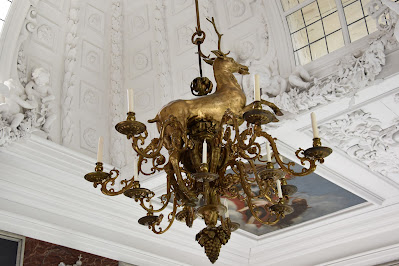 |
| Large golden chandelier in the Audience Chamber |

Painted in the four corners of the ceiling are four becoming female figures which represent the four corners of the world. At the time Denmark had colonies in each of these places and the paintings were meant to reflect this position of power which Denmark held over the world.
 |
| The first elevator in Denmark. |
One of the more exciting parts of this room is a chair located in the corner. This chair might look a little odd, and this is because it’s a chair lift that can go from this room to the floor above, which contains the king’s private apartments, just like a modern-day elevator. The chair lift was installed when the king fell ill and found it challenging to walk up the stairs between the various floors. The tour guide also told us that it was also used for when the King got bored with dealing with folk and wanted to make a quick escape...
From the Audience Chamber, head back through the Valdermarsalen, into Room number 25.
One important bit of information we learnt from one of the security personnel whilst touring the Castle was each room in the Castle was numbered and if we wanted to know which room we were in we just need to look at the numbers about the doorways and we would know where we were. This was also helpful when reading the information we were handed when paying for our tickets.
 |
 |
| Huge piece outlining the huge family tree hangs on the wall in this room. |
From this room we were straight into Room Number 26.
 |
| Amazing ceilings all adorn these magnificent rooms. |
Again when entering Room Number 27 we were taken in with this pale blue room with a gorgeous star vaulted ceiling which is dedicated to
the reign of Frederik II. Hanging above the main wood dresser are two
portraits, facing each other. This is King Frederik and Queen Sofia, who
would have made this room their bedchamber. The rest of the room is
filled with additional portraits of the bourgeois who attended court at
this time. This was the first moment in history when paintings of
non-royal members of the family were allowed to be made, so their
depictions are especially important.
 |
| Detailed work in the ceiling |
We discovered that Room Number 28 was the Noble Portrait room. This room featured a collection of paintings of the nobles of the Danish court. The most famous person on these walls is Tycho Brahe, a famous astronomer from the 1600s. Tycho Brahe was famous for the most accurate and precise observations achieved by any astronomer before the invention of the telescope. He was born to aristocratic family in Denmark in 1546, he was one of twin boys, the other twin was still born and whilst he was still a baby he was stolen from his parents by a rich, childless uncle, who paid for his education and sent him to Leipzig University to study law. His imagination had been fired, however, by a total eclipse of the sun in 1560 and he was determined to be an astronomer. He found that the existing tables recording the positions of planets and stars were wildly inaccurate and dedicated himself to correcting them.
Room Number 29 was one of the original living rooms of Christian IV. He lived in the castle beginning in 1596 when he became the king at the young age of 19. The first half of his reign was more prosperous than the second half when he was plagued with the disastrous Danish 30 years war.
The room is painted bright blue and the golden paintings set against the walls reflect the natural sunlight and appear to gleam.
The large painting above the dresser is of the king himself and surrounding him are images of his children and wives. Christian IV actually had three wives throughout his lifetime. One can only imagine by looking at his portrait whether it was his looks or his wealth that drew the ladies to him.
Each room we go into we are in awe of the ceilings and the craftsmanship of those that were responsible for the rebuilding and refurbishing of this castle. There was so much inlaid timber work in this ceiling and as one of the security guards said to us, that if we were trying to build it today, it just wouldn't be possible. Back when the castle was rebuilt the greatest cost was for materials, and labour was relatively cheap whereas today the cost of labour would certainly outstrip the cost of the materials. |
| Beautifully carved ornate chests |
When we stepped into Room Number 30 it felt like we were entering a more regal park of the castle. This room was is sumptuously decorated. The paintings on the wall depicts events from Christian IV's life, and the decor inside this room is curated to reflect the styles that would have been popular during his lifetime.
Also along the wall is a massive painting of the coronation of Christian IV in 1596. It was painted by a famous Danish artist Otto Bache in 1887. He was a Danish Realist painter and many of his works depict portraits and key events in Danish history.
 | |
| Another amazing ceiling |
The detail in the ceiling in thi room was absolutely incredible in all of it's detail and richness and I can tell you by the end of our visit to the Castle our necks were quite sore just from constantly looking up and admiring the detail and beauty of each room..
In the corner of the room, behind a beautifully panelled set of windows, is an old astronomical clock from 1644. The clock was made by Nikolaus Siebenhaar from gold plated copper on a carved wooden base. The clock was called a tellurium. The tellurium and shows the time, date, moon phase and the position of the constellations. All of which were of great importance for astronomy and astrology which influenced the king’s decisions during this time.As you can see we were pretty impressed with this room and got pretty carried away with photographing it. The other really impressive thing with the castle was all the beautiful polished timber floors. In each room of the castle the pattern of the floor was different. It i hard to beleive there are so many different ways to lay floorboards to create such lovely patterns.
We were also really impressed with Room Number 31, I mean lets be honest, which rooms weren't we impressed with. This room was Leonora Christina 's living room. Princess Leonora Christina was the daughter of Christian IV and Kirsten Munk. In 1636 she married Corfitz Ulfeldt. Leonora Christina was a favourite of Christian IV but soon after his death in 1648, she and her husband came into conflict with Frederik III and his wife Queen Sophie Amalie. In 1651 Leonora Christina and her husband fled to Sweden where they took part in conspiracies againt the Danish government.
This entire room is covered floor to ceiling in dark wood panelling. The room was inspired by the amazing works of Tycho Brahe and was given an astronomical theme. The ceoiling is the most impressive feature in the room and is covered in a painting of the zodiac symbols as they appear in their spacial constellations.The large painting on the wall of a man and woman with a few small dogs at their feet is Princess Leonora Christina and her husband Corfitz Ulfeldt.
Leonora’s husband committed treason against the king, Leonora’s
brother. Leonora herself was sent to prison by her brother for her aid
in the attempted plot.
Room Number 32 is a little corner room that we entered through the Leonore Christina Room and it occupies the corner tower room on this floor.
This room is home to a collection of minature portraits. These adorable cameos and tiny protraits were ofent worn by members of the court to show their allegiance to individual members of the royal family. Aparetnly this was of particular significance if one royal was thought to be attempting to oust the next. If you wanted to show your support of one royal over another casually, this was a subtle way of doing it...
From the minature portrait room, we headed back through Room 30 and headed upstairs to Room 34. This hallway leads you through to the second floor of the castle. The walls of the hallway are littered in painting, the most impressive of which is the "Storm of Copenhagen in 1659" which was painted by F.C. Lund. It features the night that Copenhagen was attached by the Swedes. As the seige wore on, one of the most famous quote from the king'a de defended the city was "I will die in my nest". The Swedes were defeated and suffered over 500 deaths whereas the Danes managed to deend their city fiercely and only lost 14 brave men.
This room features the most amazing wood carvings. The ceiling itself is absolutely covered in carved panels. The same strange blossoming rosettes from the oratory can be seen here paired with brightly painted circular panels.
Room Number 36 was very much about King Frederick III and Queen Sofie and it featured objects from their rule. The style of architecture and decor inside is very much of the Baroque era. It was very lavish almost bordering on pompous.
The furniture throughout this room is all exquisitely created in Germany, the Netherlands and France . The reason the furniture was not locally made was that during the reign of Frederik III, trading across Europe had started to open up making the exchange of goods and materials more popular and fashionable. The furniture is even inlaid with pieces of ebony and ivory, a way of showing off weath in every inch of the castle...
Along the walls in this room are portraits of the men who supported and aided the king in the 1600s. There were both noblemen and academics who helped lead the realm into glory.On the ceiling of the room is a grandiose painting of Sol. Sol is the Nordic sun goddess who travels through the sky in a chariot pulled by two great horses. Sol is responsible for imparting everlasting life and is thought to have created the spark of life on earth.The next room we ventured into was Room 37 which is actually known at "The Angel's Room". This room felt almost otherworldly. It was unreal... When Frederik III died, Queen Sofia continued to live in the Castle in her widowhood. She took it upon herelf to pour her grief into more decoration of the castle. She never stopped adding decorations and embellishments until her own death. Unfortunately thi room was badly damaged in the fire but was restored to it's former glory in 1859. |
| The ceiling in this room was unbelievable... |
The Angel’s Room was often used for both huge banquets and small family dinners. Displayed in the centre of the room was a model of the dining table complete with plastic moulds of the meals and foods which the court and royal family would have eaten in the 17th century.The great ceiling is painted with motifs inspired by the Doge's Palace in Venice. The paintings in the centre are of King Frederick III on the throne surrounded by the four pillars of the Danish kingdom; the nobility, the clergy, the citizens and the peasantry. In the other paintings, are allegories of war and peace.
A rather impressive painting in this room features the naval commander Peder Bredal when he freed his frozen vessels out of Nyborg Fjord. At the beginning of 1658 Charles X Gustav of Sweden sent his soldiers across the ice towards Funen and Zealand. During the Swedish shelling, Peder Bredal managed to get his ships, which were frozen in place, to safety.
Carl Neumann was commissioned to paint this masterpiece in 1883. He was one of the most famous Danish marine painters. He had a way of capturing those moments at sea which helped to shape the nation.
If Bredal would not have been able to free his ships from the ice, the soldiers would have been both lost at sea during the tough winter and they would not have been able to join the forces on land to defend their kingdom.
From Angel's Room, we checked out Gothic Globes room. This beautiful golden globe in the centre of the room was made for Frederik III. This celestial globe depicts the world view of Nicolaus Copernicus. Nicolaus Copernicus was a Renaissance-era mathematician and astronomer, who formulated a model of the universe that placed the Sun rather than Earth in the center o the universe. The entire piece took over three years to be completed in 1657.While the ceiling here is pure white, the stucco designs were made to reflect the presence of the celestial globe and also feature images of the zodiac symbols.The sky is represented around the exterior and inside the sphere are tiny gold balls which are the earth and, the moon. The other planets are also represented by smaller silver balls inside. The sun is in the centre of all of this, represented by a large brass ball. Around the exterior of the sphere are these beautiful depictions of the zodiac symbols surrounded by astronomical constellations. But the piece is not just an art exhibit, each of the objects moves based on the 24-hour clock. The room also features portraits of court mathematicians, astronomers, librarians and the heads of the Art Chambers.
We are really enjoying learning all about the remarkable Danish history. We've learn't this visit that a lot of our English language has roots in the Danish language and Danish history is one of the oldest histories in the world.
Our next room was the Great Hall. This is the room that left an indelible impresion on our last visit.. It is probably the room we spent the most time in on our last visit. We spent ages just admiring the different stories on the ceiling. It is hard to even put into words our awe at the time so we were really looking forward to coming back and taking it all in again...
The Great Hall was built for King Christian IV but was completely destroyed in the great fire. Since this room was such a HUGE showstopper there was a plethora of paintings and drawings done of the space used to faithfully recreate it. King Christian ruled Denmark from 1588 to 1648. His 59 year reign is the longest reign of any Danish and of Scandinavian monarchs. Depite the wealth displayed in this room, he instigated various war that almost bankrupted the country.
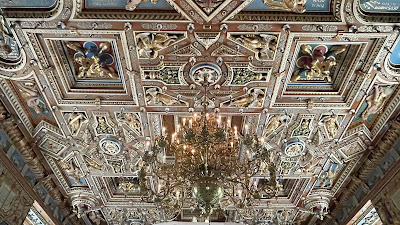 |
| The amazing and elaborate ceilings in the Great Hall. |
This fairytale-inspired room was used for balls throughout Christians’ reign. The room is set directly above the Chapel and has the same dimensions as it as well. The Hall is also known as the "Hall of Knights" as the king would often host galas for members of his royal order here.
On the side of the room is what looks like an ebony coloured canopy but is actually the great black marble fireplace. The actual fireplace is hidden behind a set of tapestries as it helps keeps the cold out. Inlaid on the black marble are beautiful scenes made from panels of pure silver. I can only imagine how gorgeous the silver would have looked in the light of the fire.
The floor in the Great Hall is also quite majestic and unlike other rooms in the Castle, the floor in here is a rich colourful marble floor that glimmers under the chandeliers and really adds to the absolute gradeur of this room.
From looking down at the floor, you can't help but look up upwards to the great
ceiling carvings. The ceiling was recreated based on artists’ sketches
before the fire. The ceiling looks like a treasure chest, piled high
with golden coins and brightly coloured jewels.
Every inch, every centimetre of the ceiling is embellished in carvings and paintings. Angels flit about among orange trees, crowned rosettes, and beautiful swirling fillagree. Scenes set into the ceiling represented the various crafts of the Danish people, such as the paper mill, the printing press, and even the watchmaker. Surrounding these scenes are allegories of God’s attributes. A balance between the godly and the earthly delights. Words cannot really describe the grandeur and photos don't really do it justice.
During our first visit to the Castle the Great Hall was empty and the curtains were drawn letting the natural sunlight to flood the room. This added to the richness of colour and everything just seemed to sparkle.
This visit we were torn between enjoying the wonderful display in there to celebrate the Crown Princess Mary's 50th Birthday but missing seeing the Great Hall in all of it's splendour.
The Display pretty much took up all the space in the Great Hall and the very heavy drapes were drawn to project a lot of the display from direct sunlight, so therefore you could not stand back and tak in all the grandeur of this magnificent room.
 |
| New 50th Birthday portrait of Crown Princess Mary of Denmark. |
The
National History Museum in Hillerød, is hosting the new
display on Princess Mary in celebration of the 50th Birthday of the HRH Crown Princess Mary. The exhibition entitled "HRH Crown Princess Mary 1972-2022" was set up in the Great Hall. It is the story of Denmark's crown princess and it is being told through portraits, personal objects as well as dresses and gala gowns that Her Royal Highness has worn ofr Special occasions.
The exhibition also includes a selection of outfits worn by the Crown Princess for various duties, journeys and celebrations.
They include her blue sequined Jesper Høvring gown, a grey Prada dress, the tiered gown she wore for Prince Frederik's 50th birthday celebrations and her white frock by Mark Kenly Domino Tan that she wore in Paris in 2019.
The display featured a new portrait of Mary painted by Spanish born artist Jesus Herrera Martinez and it contains a echalyptus tree in the background as a subtle tribute to Australia, where Mary was born in 1972.
One of the jewels of the display is Mary's royal wedding gown. Her gown was created by Danish designer Uffe Frank. It was made of an ivory duchess satin and the skirt was lined with 31 metres of tulle. The skirt featured alternating lace panels, which were revealed as she walked down the aisle, followed by a six-metre train.
 |
| Many of the beautiful gowns worn by HRH Crown Princess Mary. |
Also on display is the claret-coloured velvet gown by Brigit Hallstein that Mary has worn to New Year's events at Amalienborg four times.
One of the highlights for us though was watching the Danes reaction to Mary's school uniforms. This really fascinated a lot of the Danish folk, as they do not have school uniforms in Denmark so found it quite strange but also fascinating that their Princess had attended a school that required her to wear a school uniform. There were several Australian animals also included in the display and this was also popular especially with some of the danish children looking at the display. |
| These couple of dresses where some of the first that Mary wore to Royal engagements. |
 |
| The Royal Wedding Dress and the kilt her father wore as he walked her down the ailse. |
Mary wanted her Australian heritage present on her wedding so her bridal bouquet included a flowing trail of eucalyptus, roses and a sprig of myrtle from Fredensborg Palace.
A replica of that bouquet is now on display with Mary's wedding gown at the Natural History Museum.
After the wedding, Mary's bouquet was laid on the grave of her late mother, Henrietta, in Scotland.
The wedding ring belonging to Mary's mother, who passed away in 1997, was reportedly stitched inside her gown near her heart.
Mary's veil was first worn in 1905 by Princess Margareta of Sweden and most recently by her mother-in-law Queen Margrethe II. Mary was the first non-royal bride to wear the antique lace heirloom.
 |
| Some of the bridemaid dresses from the royal wedding. |
Although we were disappointed not to be able to see the Great Hall in all it's splendour, it was nice that if there was to be a display in there it was of the Crown Princess Mary, as we feel quite an attachment to her as she is Aussie born and bred.
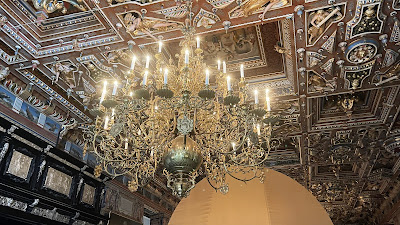 |
| One of the magnificent chandeliers in the Great Hall |
Never the les, the Great Hall does house many important and famous pieces of art, one of the most important pieces of art in the hall being the woven tapestries. The tapestries depict the life of Christian IV and are copies of original tapestries found outside the castle, having been saved from the fires. The tapestries were made specifically for the museum to restore the look of the Great Hall.
Facing in on the hall are portraits of the members of the House of Glücksburg. The house of Glücksburg has been the Danish Royal Household since Christian IX in 1863. The current reigning queen, Margaret, is from their dynasty and keeps her family’s legacy alive today. | |||||
| The current Queen |
By now it was mid afternoon again and we still had quite a bit of the castle to still view. We had skipped lunch as we didn't bring any with us and there really isn't anywhere at the castle where you can buy any. Still we were on a mission to really see the castle and learn a lot more about the history of not just the castle but Danish royalty.
 |
| Large portrait of Christian V hangs on the wall in this room... |
Our next room to view was Room 40. In this room there were items from Christian V's reign from 1670 to 1699. Christian V was the first king to be annointed in the palace. In the centre of the room is a book with the page opened to the King's Act of 1665 which was the legal basis upon which the Danish Monarchy was formed.
On the left side of the wall is a large portrait featuring Christian V in his fancy dress. It is said that seeing his face both in this room and throughout the castle always makes one feel like he’s still watching over the palace even hundreds of years after his death.
Meanwhile, Kingo preached a sermon before Frederick III that caught the king’s attention and opened doors for his future advancement. In 1668 he was ordained as the minister of Slangerup, his hometown. He had written poems as a youth, but now he turned seriously to poetry. Among his output were patriotic verses, humorous vignettes of village life—and hymns.
Count Peder Schumacher Griffenfeld was a Danish statesman and royal favourite. He became the principal adviser to King Christian V of Denmark from 1670 and the de facto ruler of the dual kingdom of Denmark-Norway in the first half of the 1670s.
He was Frederik III’s secretary and in 1668 he became councillor; he prepared the Danish Act of Succession, the constitution of the absolutist monarchy. In 1673 he was appointed Count with the name Griffenfeld, and the year after he became Chancellor, as such the highest ranking official in the Kingdom.
Griffenfeld
had many enemies in the Administration and he also came into conflict with
Christian V. In 1676 he was arrested and condemned to death for bribery and
treason, after it was disclosed that he had worked against official Danish
foreign policy. On the scaffold he was reprieved with lifetime imprisonment. He
was jailed at Holmen in Copenhagen until he was transferred to a fortress at
Trondheim in Norway in 1680. In 1698 he was allowed to live in Trondheim.
Griffenfeld was the most able Danish politician of his time, but his great
ambitions and arrogance became his downfall.
Other than the Chapel and the Great Hall this next room would be up there with my favourites...
Room 42 marks the transition between the 1600s and the 1700s. This period was marked by the Baroque style. Baroque and Rococo as they are synonymous with ostentatiousness and grandeur. Instead of wallpaper decorating the walls, they were covered in huge woven tapestries. These tapestries depicted scenes of Alexander the Great entering Babylon and the battle of the Persian kings. They were fantastical depictions of the greatest rulers from history. The tapestries were made in Louis XIV’s factory in Paris and were made by the very best weavers around the world.
 |
| Breathtakingly beautiful rooms |
The beautifully carved and upholstered canopy bed was made in Paris around 1724. They called this style of bed a “parade bed”. It was made for Christian V when he married Christine Catherine von Holstein in 1724. You can see their monograms, CDS and CCH, carved into the bedframe. My very favourite part of this bed is the silver fireguard which sits in front of the bedroom to protect it from the sparks of the fireplace. It’s shaped into a heart and feels like it warms the room, even without a fire.
 |
| Beautiful tapestries adorn the walls |
 |
| Amazing craftsmanship in this inlaid table top. |
You can see that we really loved this room by the number of photos we took.
The next room we entered was also very impressed. Room 43 centred around the large painting of King Frederick IV. He reigned from 1699 to 1730. Frederick didn't have the best time ruling the kingdom. During his reign, Copenhagen was struck with both the great plague of 1711 and the great fired of 1728, which destroyed most of the capital.
Wanting to escape Copenhagen,
Frederick spent much of his time building onto Frederiksborg Palace.
While Frederick wasn’t much of an academic, he loved art and
architecture and it is perhaps for this reason that the castle became so
magnificent. Chinese imports were becoming all the rage in this time
and many of these oriental objects can be seen in this room.
 |
| Each floor to each room had a different pattern in the floorboards.. |
The patterning in the floor boards never ceased to amaze us as each room we went into was so different.
Heading into another one of the tower rooms we came to Room 44 where there were a number of portraits of prominent figures of Frederik's IV's reign. The thing that stood out the most in this room though was the golden leather wallpaper which had been applied to the walls. This leather wallpaper appears throughout the castle but it was most notable in this room for its size and grandeur
 |
| The leather wallpaper in this room was quite impressive.. |
 |
| The castle was full of beautifully deigned impressive furniture... |
 |
| More intricately carved ceilings... |
 |
| More of the intricately inlaid furniture.. |
From Room 44 we entered "The Princess Wing" A long pink hallway runs down this side of the castle with various rooms extending off of it. Most of the objects and paintings in this area are from the reign of Frederik IV and Christian VI from the first half of the 18th century.
 |
| More beautiful ceilings and patterned floors |
The Rococo style began in France in the
1730s as a reaction against the more formal and geometric Style of Louis
XIV. Rococo dressers line the hallway, marked by their curves and
sculptural moulding.
 |
| The gold detail in the ceilings.. |
Exiting back into the hallway, we found that the walls have changed colours from the pastel blush pink, to mustard yellow. Along the walls were vintage pieces of furniture from the 1800s. But the most impressive part of this corridor is the gold plated ceiling. Inlaid with images of Roman leaders, they look almost like giant coins glued onto the ceiling.
The rooms existing of this hallway were extremely decorative and stunning and left us gob smacked again even though we had seen them before. Each time we visit we notice more detail or maybe different detail but it is equally impressive.
Room 47 was a pale blue room decorated with a myriad of the golden frames was from the time of Christia VI who ruled from 1730 to 1746. Various paintings in this room feature Queen Sofia Magdalene and her children.
 |
| This unusual bowl caught our attention - shaped in the shape of a bishop's hat. |
We were fast running out of time to see the rest of the castle. I think we only had about an hour left before closing time so we needed to keep moving.
Continuing through the room we headed into Room 48 which was a beautiful light rose coloured room which contained more objects from the 18th century.
Two portraits of Frederick V by Carl Gustaf Pilo cover the walls. Pilo was a Swedish artist and painter. He worked extensively in Denmark as a painter to the Danish Royal Court and as a profesor and director at the Royal Danish Academy of Art, as well as in his native Sweden. He was also responsible for most of the rococo designs throughout the castle during this period. He was the king’s personal stylist and interior decorator.
The furniture in this here is much lighter than in previous generations.
Patterns are no less opulent but the subtle tones make it feel less
busy. There is definitely an air of elegance over opulence here.
Talking to the secuity guards throughout the Castle added a lot to our experience here as they shared with us some of the history we would otherwise not have been aware of.
In Room 50 we learnt about a rather turbulent figure in the royal household. During Christian VII's reign his wife was having an affair with a man named Johann Friedrich Struensee. Struensee, came to King Chritian VII's court as his personal physician. The mentally unstable king struck up a close friendship with his doctor, while Struensee began an affair with the queen, Caroline Mathilda. During this period, Struensee had a strong influence over the king and used it to become the de facto ruler of Denmark.
Struensee was a follower of the Ënlightment"and as Denmark's "dictator", he passed more than 2200 laws from 1769 to 1772 which limited the powers of the nobility, changed labour laws, and instituted freedom of the press among other things. In 1772, when the King dicovered his treachery with help of the King's mother and the disenfranchised aristocracy had Struensee arrested, tried for treasona nd then executed for crimes against his majesty.
His portrait still hangs in this room in the castle, and we were told rather jokingly that it is probably there as a reminder to those who might attempt to do the same.The next room we entered was again filled with many more portraits of many more prominent Danish figues from a past era. The Chandeliers, ceilings and again the floors and decorations all had standing in awe of the opulence and craftsmanship.Room 52 features dignified furniture in the style of Louis XVI. The canopy sofa with a gold plate actually pulls out to be a double bed. This room shows how the castle was starting to modernize with the times. The tableware in here is another gorgeous example of the style of Rococo flatware with botanical imagery all over it which was a popular icon on the style.
Room 55 is one of the plainer coloured rooms but the sheer number of paintings on the wall makes it no less interesting. On the wall opposite the window, are two grand pictures of the Battle of Copenhagen in 1801, depicting the vanquished Danish fleet. Despite this great military loss, the early 1800s were a boom time for the Danes. It was a golden age for art, literature, and science. Portraits on the wall reflect the various men and some women who helped shape this golden age. In the room is a set of Danish Imperial living room furniture, covered in rich red leather, which belonged to the household of Frederick VI.
The next lot of rooms we had to rush through, so I guess we will need to come again as we didn't have time to look into too much of the history of these rooms in the Castle.
 |
| Lots of inlaid timber |
From here we headed into Room 57, also known as the "Gable Room", this room was full of portraits of poets, and artists from the Danish Golden Age. Whilst a lot of the name were not familiar to us there were a couple we had heard of...
You’ll find pictures of actress Johanne Luise Heiberg, an actres that we had never heard of. Apartently she was the most celebrated Danish actress of the century. She grew up in a divided and discordant family in Copenhagen. Her parents were poor German emigrants, her father Catholic, her mother Jewish, and she was the second youngest of nine children. She started at the Royal Danish Theatre Ballet School in 1820 and made her debut as an actress in 1826. Four years later she moved into the home of Thomasine Gyllembourg, marrying her son, Johan Ludvig Heiberg, a year later. The painting of her in this room was commissioned by her husband Johan Ludvig Heiberg. It was painted in the middle of the crisis that would lead to their eventual breakup. Her stern face clearly reflects her cross feeling about sitting for the portrait with a man she no longer was the biggest fan of.
We did recognize the protrait for the poet H.C. Andersen. To us we knew him for his amazing literary fairy tales, he was in fact a famous Danish author and a prolific writer of plays, travelogues, novels and poems.
Another of the portraits belongs to the artist Nicolai Wilhelm Marstrand who was born in Copenhagen, Denmark, to Nicolai Jacob Marstrand, instrument maker and inventor, and Petra Othilia Smith. Marstrand is one of the most renowned artists belonging to the Golden Age of Danish Painting.
The change in who is portrayed in castle portraits, from the royals to portraits of celebrities shows the shift in power dynamics during this time of Danish history.
The chandelier in the center of this room was inexistite. It is one of the most impressive designs, with large round orbs hanging from it, it looks almost like a mythical fruit tree. It’s a big departure from the traditional chandelier designs throughout the rest of the castle and is another example of the change in both power and design during this era.
In the next room we walked into , again the ceilings took our breath away, the big drawcard for both Steve and I in visiting this castle has always been the elaborate ceilings and the amazing timber floors, and everything else jut addes to the greature. In this room, two things stood out, first the bust of the great linguist Rasmus Kristian Rask. Rask travelled the world studying Icelandic grammar and Oriental languages and is considered one of the founders of modern linguistics. Beside the statue of Rask was a very stately looking telescope whose design was from the mid-1800s. It was once used by Johan Ludvig Heiberg when he visited the palace. |
| Again, the amazing ceilings... |
This room then led us to the stairs back down to the 1st floor to Room 61. This room is commanded by a huge paiting of the "Constitutional Assembley" from October 1484.
This was when the king gave up his monarchical powers and when the first democratic election in Denmark took place. This painting showcases the famous Danish politicians from Danish history
 |
| Two large paintings of the great heroes of the War... |
 |
| Part of the ceiling |
Entering our next room, we found that this room was created for not crown royalty, but for the great poet Adam Oehlenschlager. On the 100th anniversary of his death, the museum collected objects and paintings of the great Nordic poet and dedicated this room to his memory.
Room 65, which was where we were headed next, was another room dedicated to one of the wars. This room features images from the war of 1864 where Prussia and Austria both attacked Denmark during this time. The war only ended when Denmark agreed to hand over parts of their land to Austria but managed to hold onto the small island of Ærø.
Another majestic ceiling. The ceiling in this room features a large central painting depicting Jupiter and Juno. Juno and Jupiter are
husband and wife and considered to be the King and Queen of the gods.
They are often seen in Royal residences, as the royals are thought to be
their earthly counterparts. Juno is the goddess of marriage, and
childbirth and Jupiter was the god of the sky and thunder.
We are noticing as we move along in this wing, that the rooms now are not so much about the royal family but wars or famous Danes who have made significant contributions to their country.
Room 66 was dedicated to the businessmen of the 19th century who helped move the Danish economy along. Agriculture, the dairy industry, shipyards, railways and breweries were booming and the various men in this room had a large part in their success.
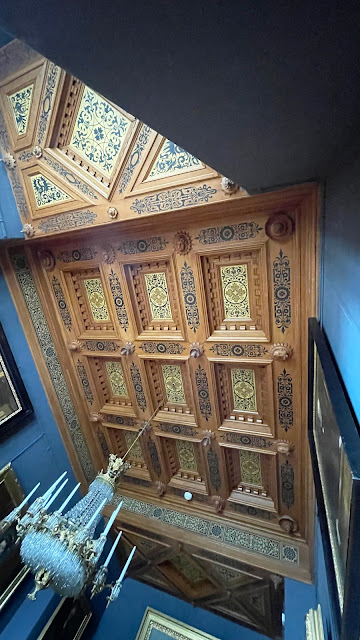 |
| Again exquisite
inlaid ceilings - masterpieces |
 | |
| Amazing Chandeliers... |
 |
| Close up of the beautiful work in the ceiling... |
We were fast running out of steam by the time we got here, we were tired, our feet hurt, we were thirty and hungry as we really hadn't eaten all day or had much to drink. I think by the time we got to this room we had about half an hour before the Museum wa due to close...
By the time we reached room 67, we start to see images from the Glucksborg family once more. Upon the death of Frederick VII in 1863, the throne passed to Christian IX who was a member of the Glucksborg family and this is when their reign would commence. Denmark's current Queen Margrethe II.
Queen Margrethe II has just celebrated her reign of over 50 years as Denmark's monarch. She is Europe's longest-serving current head of state. She was born into the House of Glücksburg, a cadet branch of the House of Oldenburg, Margrethe is the eldest child of Frederick IX of Denmark and Ingrid of Sweden.
The furniture in this room is the most modern, all
coming from the 19th and 20th centuries.
 |
| Another amazing ceiling... |
 |
| Just look at all the detail in the ceiling.. |
 |
| The cornices of the ceiling... so detailed... |
 |
| Portrait of J.C. Jacobsen - founder of Carlsberg Brewery & also responsible for the repair of the Castle |
There is so much more to this castle that we haven't seen today. The Baroque Gardens are a sight to behold also and you could easily spend a whole day just wandering though them also. These gardens which surround the castle were designed in the typical style of the age. They were created by architect J. C. Krieger in 1725. Baroque gardens during this time were designed in a symmetrical pattern and used hedges and gushes to creat an outer structure.
Within the lower portion of the gardens, the hedges are carved into unique patterns which form the Royal monograms. These monograms are of Frederik IV, Frederik V, Christian VI and Margrethe II. They are all the monarchs who ruled within the walls of this castle.
Toward the far end of the garden, off to the left is a series of small lakes, a bathhouse and an English style garden. This is also sometimes called the Romantic garden as it presents the uncurated and raw beauty of nature in contrast to the highly manicured and planned structure of the baroque garden.
We did spend quite some time wandering around these gardens on our last visit to the Castle so really wanted our main focus today to be inside and on top of that the weather lent itelf to more inside activities rather than being outside in the wet and cold....
We also noticed a small ferry giving rides across the lake which looked like it might be a nice way to spend an hour or so, and it was pretty reasonably priced too so may look into taking a little cruise on it when we next visit.
By now it was going on for 6pm and we still had a good half hour drive before arriving home...
The walk back to the car was lovely. The scenery around the lake is just beautiful, we stopped to watch the geese and then to watch the beautiful white swans as they glided by us on the lake...
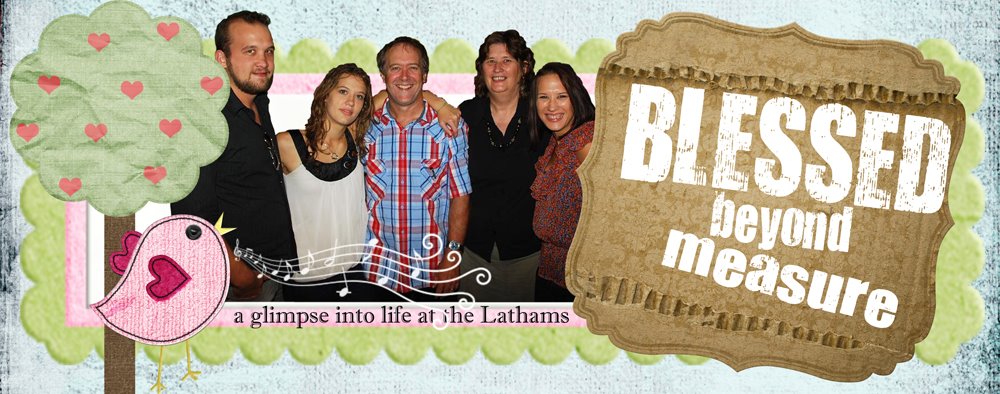


















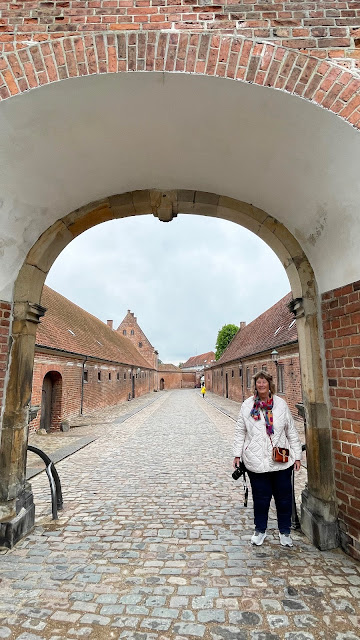










































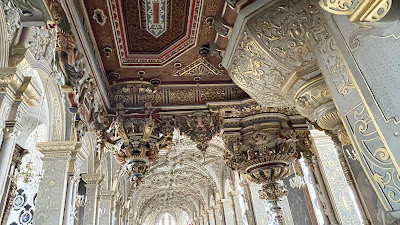






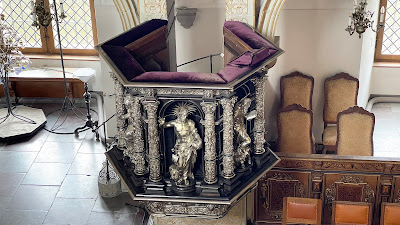
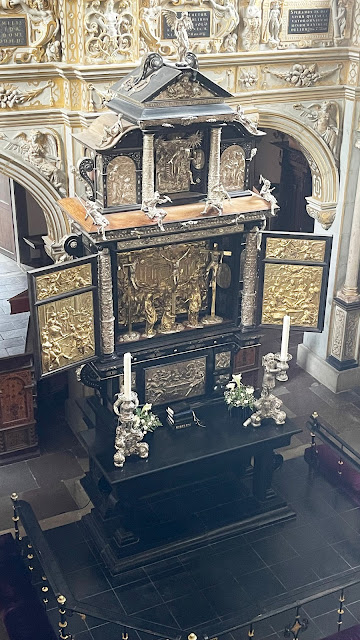






































































































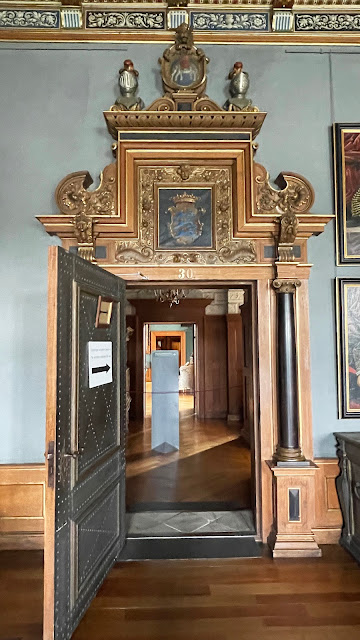










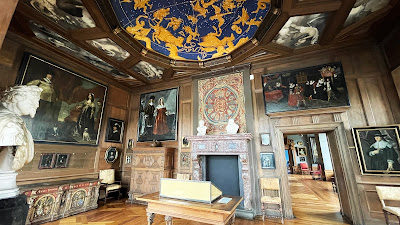
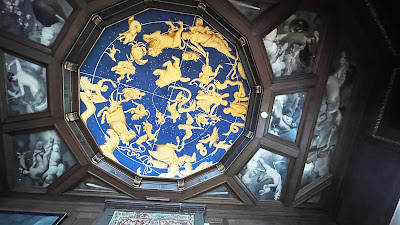




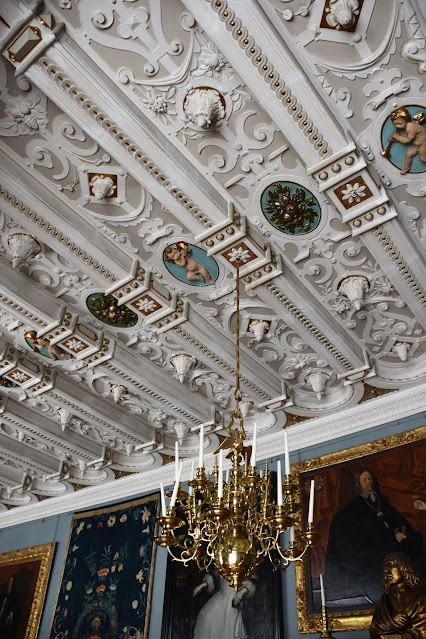




























































































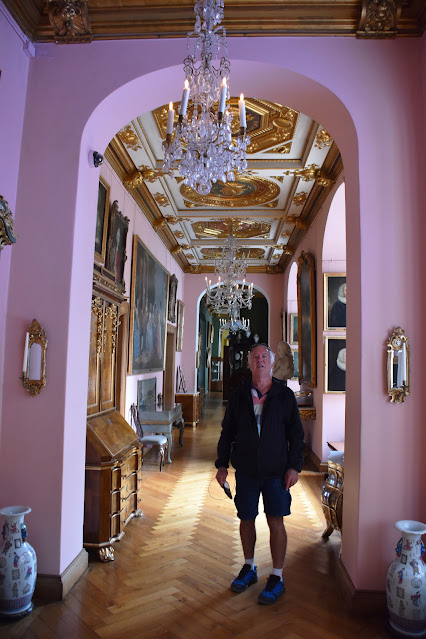



















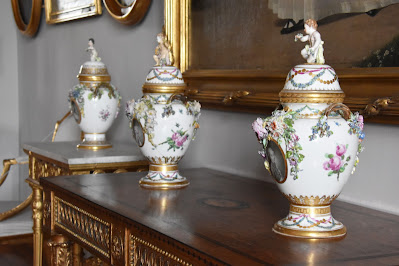
















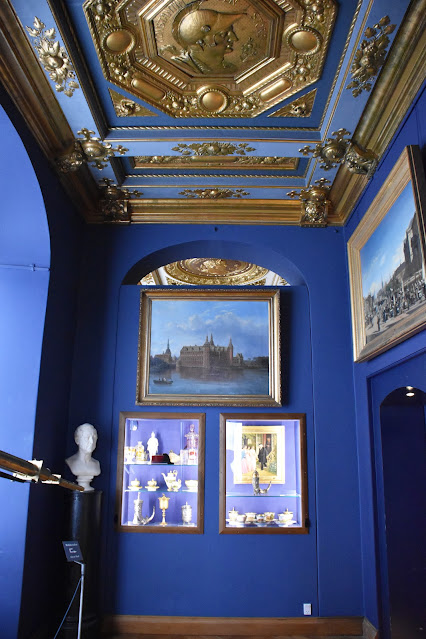






















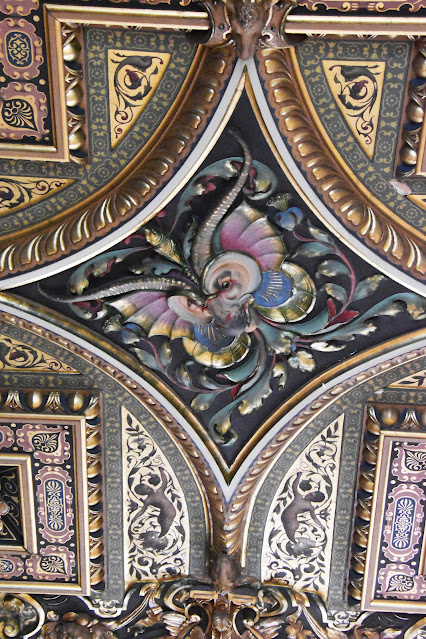


















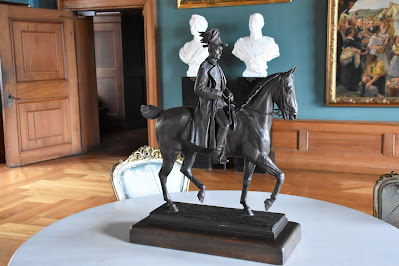









































0 comments:
Post a Comment